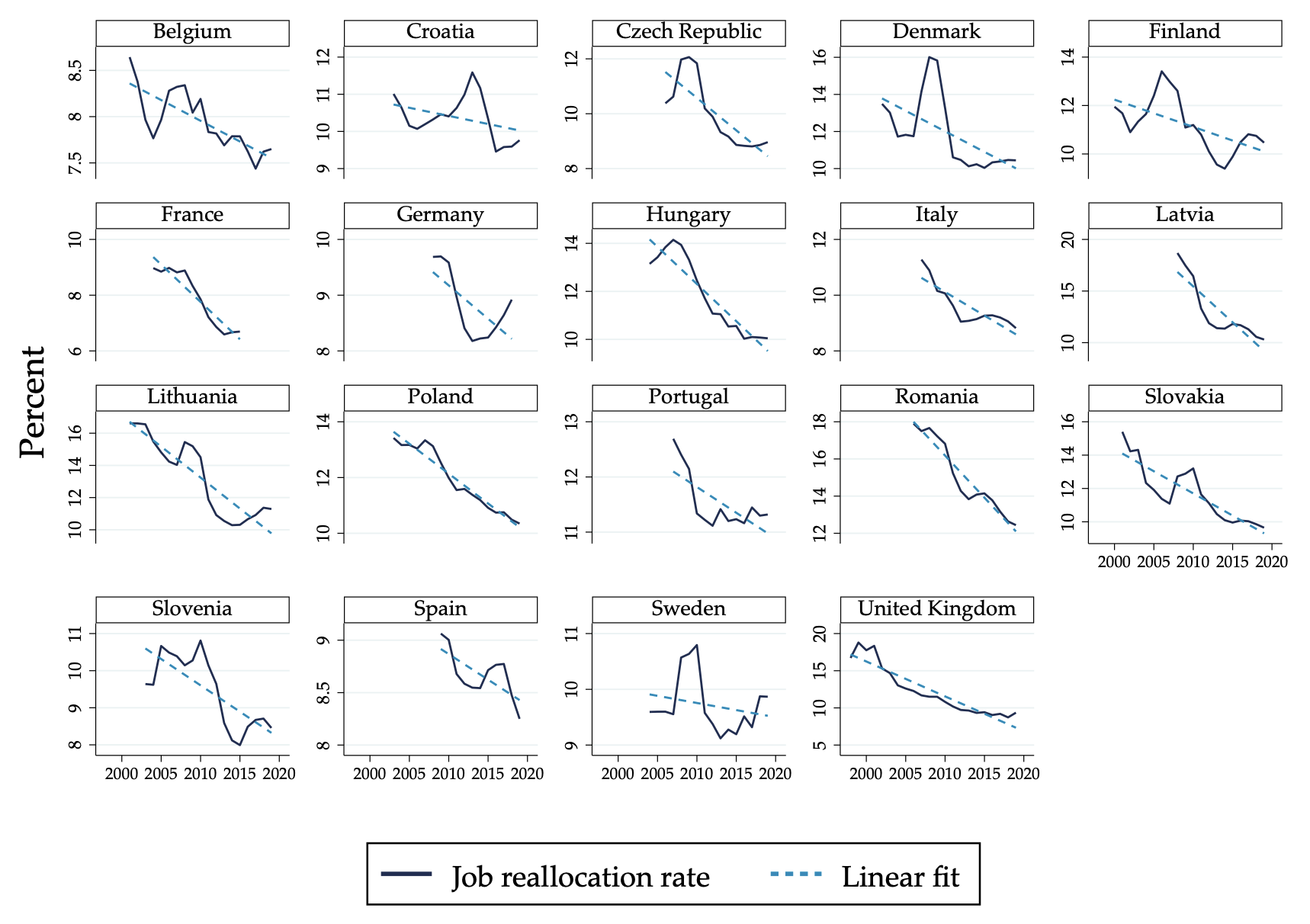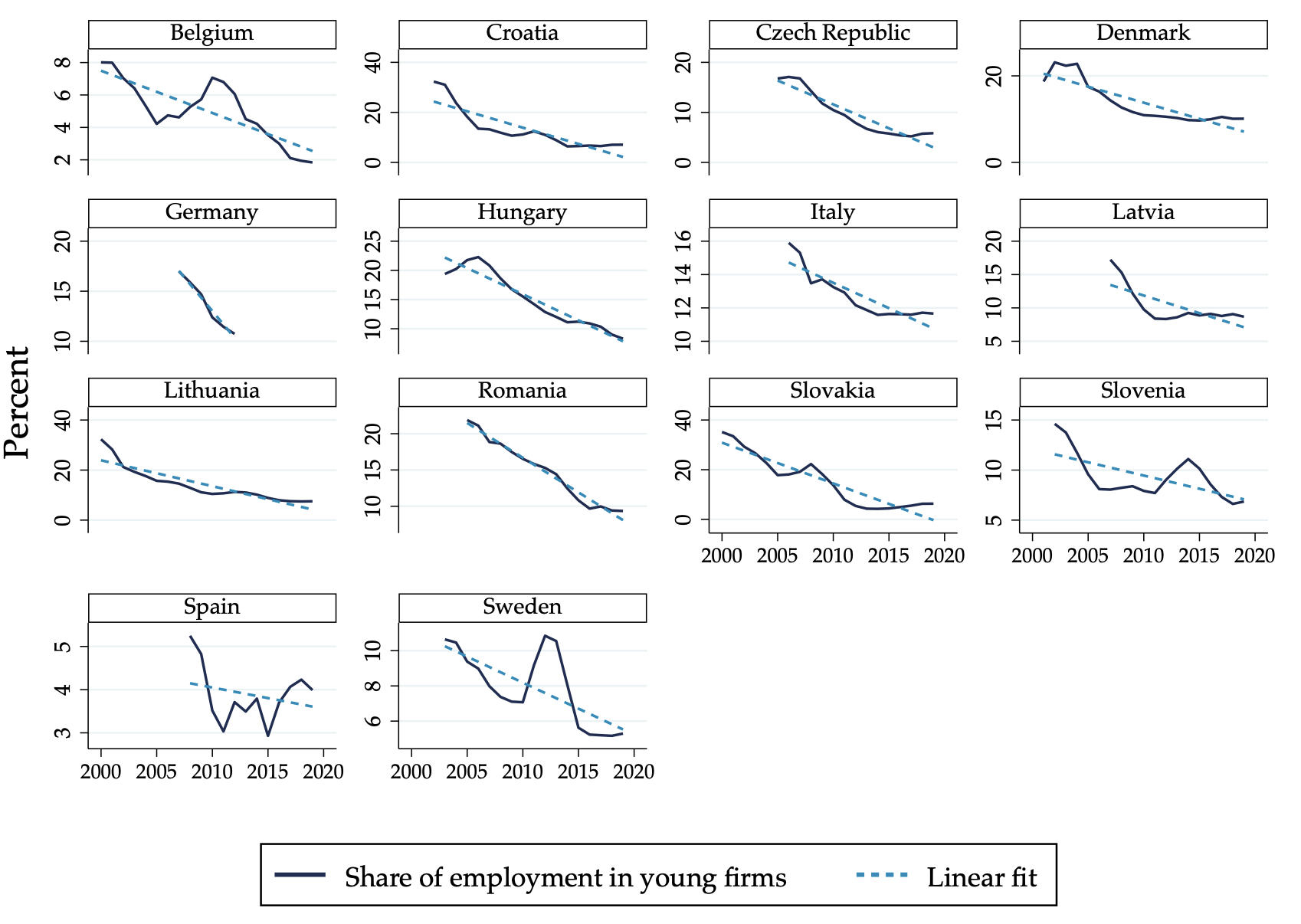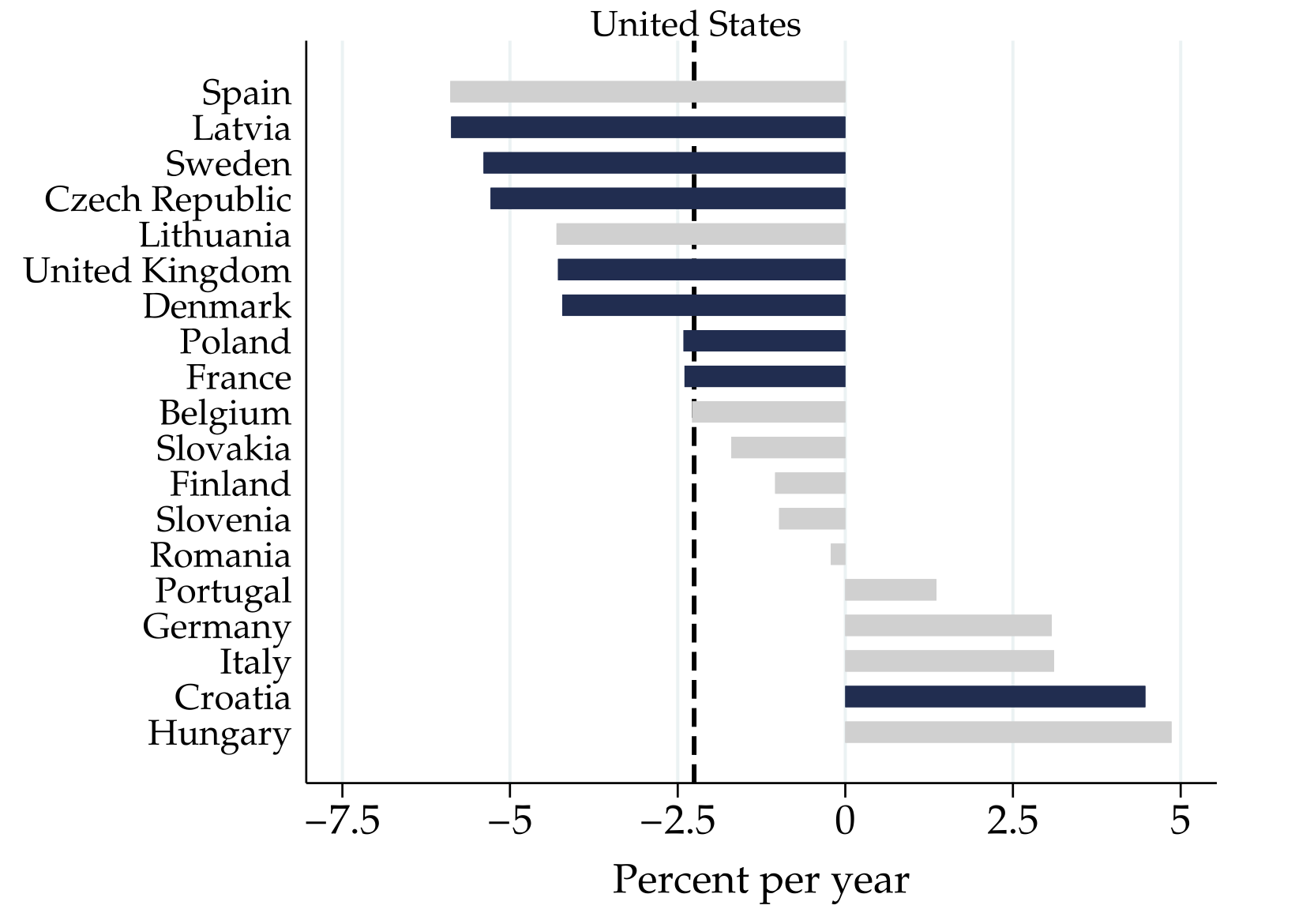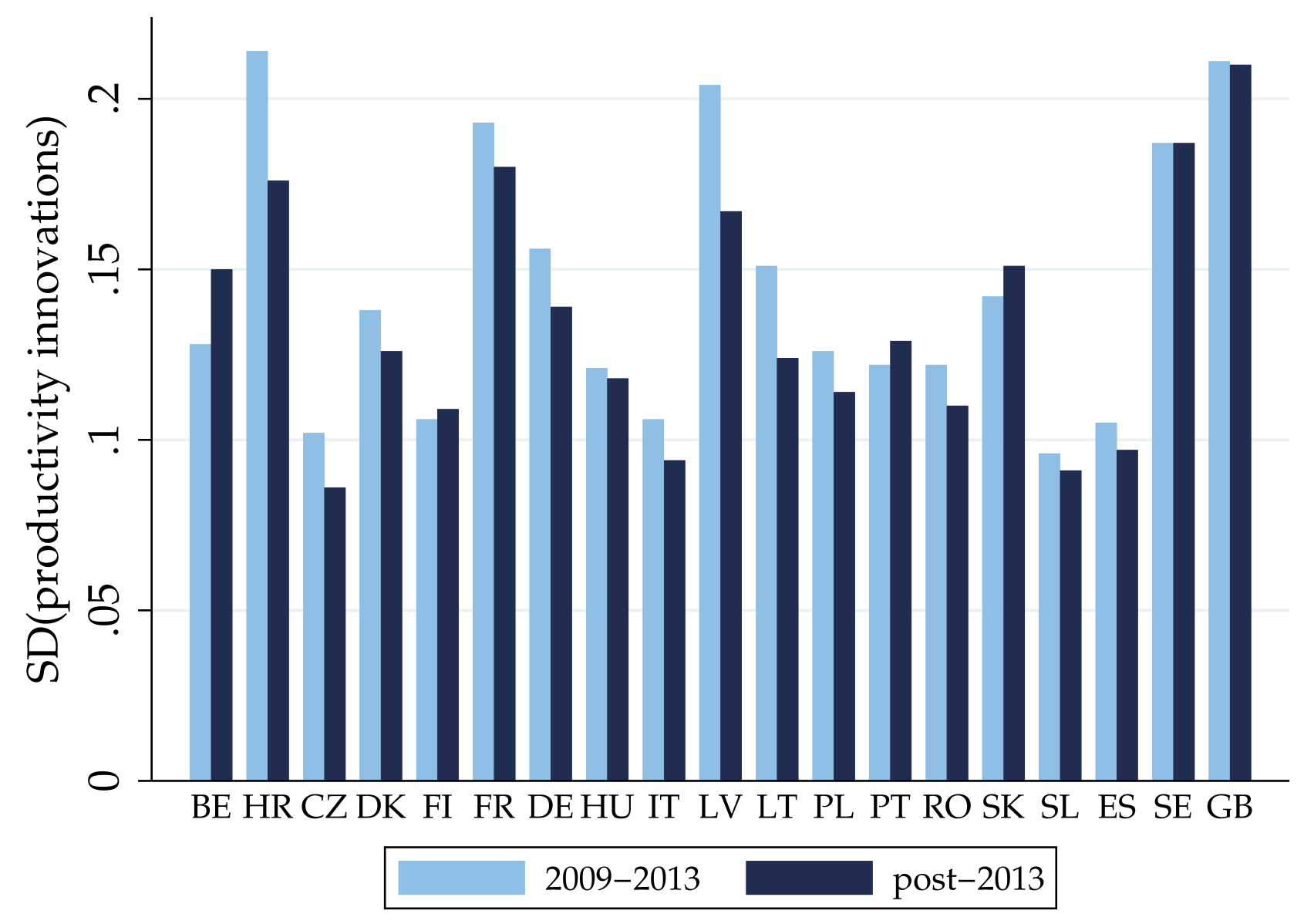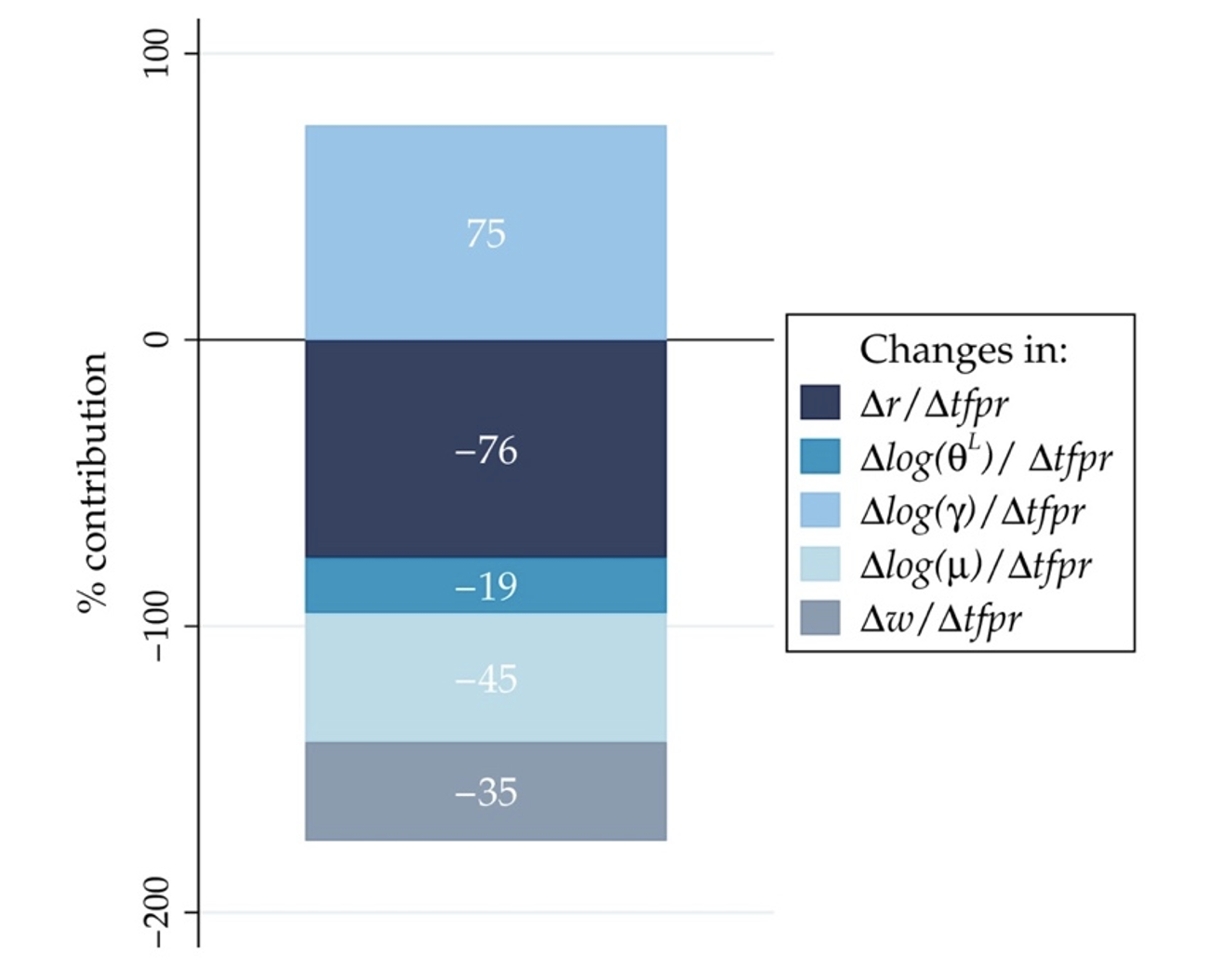One of the most debated macroeconomic trends in the past decades has been the decline in US business dynamism, due to its importance for aggregate productivity growth (Alon et al. 2018, Miranda et al. 2016, 2018, Sedlacek et al. 2018, Sterk et al. 2021, Decker et al. 2020), and the pace of economic recoveries (Pugsley and Şahin 2019). The slowdown in the process of birth, expansion, and contraction of firms has been documented with a variety of measures and data sources in the US (e.g. Decker et al. 2014, 2016a, 2016b, Dent et al. 2016, Guzman and Stern 2020, Akcigit and Ates 2019, 2021).
However, the economic factors driving this decline remain subjects of ongoing debate. Moreover, evidence on business dynamism outside of the US, and in particular for Europe, is limited to a few country-specific studies (e.g. Bijnens and Konings 2018, 2020, Andrews et al. 2016, 2017, Citino et al. 2023, Hambur 2023) or reports by the OECD for a sub-sample of European countries (e.g. Calvino and Criscuolo 2019, Calvino et al. 2020, Verlhac et al. 2022) due to lack of cross-country comparable data.
In a recent paper, we bring novel European data to this debate (Biondi et al. 2023). Our main contributions are (i) to collect and publish new data for 19 European countries on business dynamism, (ii) to document a widespread decline over the past decades also in Europe, (iii) to analyse and quantify the relative importance of the microeconomic drivers underlying this decline, and (iv) to derive a framework that connects changes in firms’ productivity, market power, and technology to changing business dynamism.
Business dynamism in Europe
The main challenge researchers face when analysing business dynamism in Europe is the lack of comparable firm-level data across countries. We address this by distributing harmonised data collection protocols across national statistical institutes and central banks in 19 European countries through the Competitiveness Research Network (CompNet) infrastructure.
With this novel database, we document a series of new facts on business dynamism in Europe. As measures of interest, we focus on aggregate job reallocation rates and young firm activity. Figure 1 presents the trends over the last two decades for these two measures using data for firms with at least 20 employees.
Job reallocation rates capture the intensity of job flows between firms resulting from job creation and job destruction. We document a strong decline in this measure (Panel A) in all 19 countries under analysis, with even stronger declines among Eastern European countries. This decline is broad-based, spanning all economic sectors and has been of similar magnitude compared to the US.
Concurrently, the employment shares of high-growth young firms declined substantially (Panel B), suggesting that the European economy is experiencing a structural aging as start-up rates decline. However, compositional changes away from young firms explain a relatively small share of the overall decline (18%). Instead, the decline is mainly driven by dynamics within sectors, size-, and age-classes. In particular, large and mature firms, and the Manufacturing, Wholesale/Retail, and Services sectors, which account for most economic activity, show the strongest reduction in job reallocation.
Figure 1 Business dynamism indicators in Europe
A) Job reallocation rates
B) Share of employment in young firms
Note: We plot the three-year moving average for each time series. Job reallocation rate = Job creation rate + |Job destruction rate|. Firms are defined as young if registered less than five years before. Authors’ calculations based on CompNet data, firms with at least 20 employees. The time coverage differs by country and ranges between 1997 and 2019.
Mechanisms: Shocks and responsiveness
Drawing on widely used models of firm dynamics, Decker et al. (2020) (henceforth, DHJM) show that a broad decline in the pace of job reallocation can be rationalised by two potential mechanisms. First, a decline in the dispersion of firm-level productivity shocks. Second, the decline in the responsiveness of firms’ labour demand to those productivity realisations. DHJM provide evidence that the dispersion of shocks experienced by US firms (and establishments) rose over the 1981-2013 period, whereas their responsiveness experienced sharp declines particularly post-2000.
We examine the same mechanisms in Europe. Similar to DHJM, we find evidence in many countries of a significant decline in the responsiveness of firms’ employment to productivity. Figure 2 plots the yearly relative changes in responsiveness in each country. In relative terms, the magnitude of this decline in responsiveness is comparable to the US – reported with a dashed line.
Figure 2 Relative decline in responsiveness in Europe
Note: The bars plot the estimated relative decline in firm-level responsiveness. The bar is coloured in blue when our results on both responsiveness and the trend variable are statistically significant at the 10% level. CompNet data, firms with at least 20 employees.
Regarding the dynamics of productivity shocks, we find a notable difference compared to the US. Figure 3 reports our estimates of the dispersion in firms’ productivity innovations over time. We document a reduction in the dispersion of productivity shocks in most European countries, suggesting that the business environment has become less turbulent from a technological and/or competitive perspective in recent times (2009-2017).
Figure 3 Decline in the dispersion of productivity shocks
Note: In each country, we estimate, before and after 2013, an AR(1) process for revenue-based productivity controlling for industry-year fixed effects. The bars plot the standard deviation of the estimated residual productivity shocks. CompNet data, firms with at least 20 employees.
Using more detailed firm-product-level data from the German manufacturing sector spanning a longer time period (1995 to 2017), we confirm all these results and estimate that the decline in responsiveness explains around 40% of the observed decline in job reallocation. The remaining 60% can be attributed to changes in productivity shock dynamics. This result differs significantly from the US, where the decrease in responsiveness rationalises the entirety of the reduction in job reallocation.
Market power and technology
The decline in responsiveness can be rationalised through adjustment costs or through changes in technology and correlated wedges or distortions (see DHJM for a discussion). In the paper, we build on previous work (Decker et al. 2020, Biondi 2022, Mertens 2022), and derive a general production-side framework that connects changes in job reallocation and responsiveness to changes in firms’ market power (in labour and output markets), technology, and wages.
Particularly, we show analytically that firm responsiveness can be expressed as the sum of the pass-through of productivity shocks to sales, markups, wage markdowns, output elasticity of labour, and wages. In Figure 4, we use our framework to analyse the contribution of these pass-through terms to the change in labour responsiveness. As shown, responsiveness has declined primarily due to weaker sales growth (dark navy) and stronger markup (light blue) increases in response to productivity changes. Although to a lesser extent, labour-substituting technological changes (dark blue) and wage (grey) changes contributed to lowering firm responsiveness too. Changes in wage markdowns (blue) actually increased responsiveness, but this has been overcompensated by the changes in the other factors mentioned above.
Figure 4 Relative contributions to declining responsiveness
Notes: Contribution of the labour demand components to the decline in responsiveness between 1995-1996 and 2016-2017. Employment-weighted averages across firms with a productivity change of at least 1%. German microdata.
Conclusions
Our results have important implications. Combined with existing evidence from the US, the widespread decline in job reallocation in Europe indicates that declining business dynamism is a general phenomenon present in many advanced economies, with partly very different labour institutions. Differently from the US, however, we show that declining job reallocation in Europe is the result of both muted productivity shock dynamics that induce less reallocation as well as lower responsiveness of firms.
Finally, our analyses offer additional explanations for declining job reallocation rates, which are alternative to rising adjustment costs. We show firm’s declining responsiveness is a response to endogenous changes in firm’s sales, market power in both output and labour markets, wages, as well as production technologies. Understanding whether declining responsiveness and job reallocation result from firms' market power or from technological change has first-order priority, and we believe that our framework, or extensions of it, can be applied by other researchers and to other datasets to shed further light on the drivers of declining business dynamism around the world.
References
Akcigit, U and S T Ates (2019), “Knowledge in the hands of the best, not the rest: The decline of US business dynamism”, VoxEU.org, 4 July.
Akcigit, U and S T Ates (2021), “Ten facts on declining business dynamism and lessons from endogenous growth theory”, American Economic Journal: Macroeconomics 13(1): 257–98.
Alon, T, D Berger, R Dent and B Pugsley (2018), “Older and Slower: the Startup Deficit’s Lasting Effects on Aggregate Productivity Growth”, Journal of Monetary Economics 93: 68–85.
Andrews, D, C Criscuolo and P Gal (2016), “The Best versus the Rest: The Global Productivity Slowdown, Divergence across Firms and the Role of Public Policy”, OECD Productivity Working Papers No. 5.
Andrews, D, C Criscuolo and P Gal (2017), “The best vs. the rest: The global productivity slowdown hides an increasing performance gap across firms”, VoxEU.org, 27 March.
Bijnens, G and J Konings (2018), “Declining business dynamism and information technology”, VoxEU.org, 19 July.
Bijnens, G and J Konings (2020), “Declining Business Dynamism in Belgium”, Small Business Economics 54: 1201–1239.
Biondi, F (2022), “Firm Productivity and Derived Factor Demand under Variable Markups”, Working Paper.
Biondi, F, S Inferrera, M Mertens and J Miranda (2023), “Declining Business Dynamism in Europe: The Role of Shocks, Market Power, and Technology”, Discussion Paper.
Calvino, F and C Criscuolo (2019), “Business Dynamics and Digitalisation”, OECD Science, Technology and Industry Policy Papers No. 62.
Calvino, F, C Criscuolo and R Verlhac (2020), “Declining Business Dynamism: Structural and Policy Determinants”, OECD Science, Technology and Industry Policy Papers No. 94.
Citino, L, A Linarello, F Lotti, A Petrella, E Sette and E Di Porto (2023), “Creation, Destruction and Reallocation of Jobs in Italian Firms: an Analysis Based on Administrative Data”, Bank of Italy Occasional Paper No. 751.
Decker, R, J Haltiwanger, R Jarmin and J Miranda (2014), “The Role of Entrepreneurship in US Job Creation and Economic Dynamism”, Journal of Economic Perspectives 28(3): 3–24.
Decker, R, J Haltiwanger, R Jarmin and J Miranda (2016a), “Declining Business Dynamism: What We Know and the Way Forward”, American Economic Review 106(5): 203–07.
Decker, R A, J Haltiwanger, R S Jarmin and J Miranda (2016b), “Where has all the skewness gone? The decline in high-growth (young) firms in the US”, European Economic Review.
Decker, R, J Haltiwanger, R Jarmin and J Miranda (2020), “Changing Business Dynamism and Productivity: Shocks versus responsiveness”, American Economic Review 110(12): 3952–90.
Dent, R C, F Karahan, B Pugsley and A Sahin (2016), “The Role of Startups in Structural Transformation”, American Economic Review 106(5): 219–23.
Di Mauro, F and C Syverson (2020), “The COVID crisis and productivity growth”, VoxEU.org, 16 April.
Di Mauro, F, P Lopez-Garcia and M Colombo (2019), “Granular inputs to policy and research: The latest vintage of the CompNet dataset”, VoxEU.org, 11 February.
Guzman, J and S Stern (2020), “The State of American Entrepreneurship: New Estimates of the Quantity and Quality of Entrepreneurship for 32 US States, 1988-2014”, American Economic Journal: Economic Policy 12(4): 212–43.
Hambur, J (2023), “Business dynamism, labour market concentration, and monopsony power”, VoxEU.org, 5 July.
Mertens, M, F Di Mauro, M Melitz and T Bighelli (2020), “Increasing market concentration in Europe is more likely to be a sign of strength than a cause for concern”, VoxEU.org, 13 October.
Mertens, M (2022), “Micro-mechanisms behind Declining Labor Shares: Rising Market Power and Changing Modes of Production”, International Journal of Industrial Organization 81, 102808.
Miranda, J, J Haltiwanger, R Jarmin and R Decker (2016), “The decline of high-growth entrepreneurship”, VoxEU.org, 19 March.
Miranda, J, J Haltiwanger, R Jarmin and R Decker (2018), “Leaving money on the table: Declining responsiveness and the productivity slowdown”, VoxEU.org, 12 July.
Pugsley, B and A Şahin (2019), “Grown-up Business Cycles”, The Review of Financial Studies 32(3): 1102–1147.
Sedláček, P, V Sterk and B Pugsley (2018), “Disappearing gazelles: New evidence from administrative data”, VoxEU.org, 11 May.
Sterk, V, P Sedláček and B Pugsley (2021), “The nature of firm growth”, American Economic Review 111(2): 547-579.
Verlhac, R, F Manaresi, F Calvino, C Criscuolo and S Agresti (2022), “Tracking business dynamism during the COVID-19 pandemic: New cross-country evidence and visualisation tool”, VoxEU.org, 17 January.





